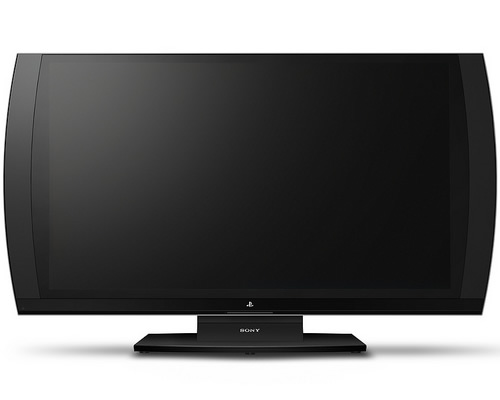
Sony’s releasing its own PlayStation branded screen complete with a 24” inch 1080p LCD display. The screen ($500) will also be 3D-capable and offers a cool feature which improves the two player experience with a technique that gives each player a full view of the game when wearing 3D glasses, no more split screen. Available Fall.
Via: Acquiremag.com
The case against Sony’s PlayStation 3D HDTV
Whatever happened to virtual reality? Trumpeted as the wave of the future, its bulky headsets were supposed to plunge us into an immersive world that would make our own look drab by comparison. VR machines briefly sprouted up in malls around the country in the 1990s (to the delight of stoned teenagers, mostly), but discerning gamers never took to it and the excitement seems to have fizzled out. Will the same thing happen to the current push for 3D?
Hype about 3D gaming has risen sharply with the increase in popularity of 3D films since 2009 — a trend that may be reversing itself. In the game world, the buzz hit a fever pitch this past Monday night with the unveiling of Sony’s upcoming 3D HDTV, built to be compatible with the PlayStation 3. Although the price seems attractive, the silent-weapon-for-quiet-wars feature is a new display mode that eliminates split-screen, allowing two players to see totally separate full-screen images at the same time.
Has Sony finally delivered the breakthrough device that will drive 3D adoption? Despite the device’s promise, there are still a lot of reasons why the PlayStation 3D HDTV may not be the game-changer Sony is hoping for. Those reasons after the jump.
Here’s the 3D HDTV combo bundle in question (click to see it larger):
Affordability
The $499 price tag of Sony’s TV includes an HDMI cable, active shutter glasses (which retail separately for $70), and the upcoming first-person shooter and PlayStation 3 exclusive, Resistance 3. For people who own a PlayStation 3, it’s not a bad deal. People who have previously opted for the Xbox 360 will have to shell out more money for a console in addition to the TV set, and people who just purchased a 3D TV will have to go through the forehead-slapping indignity of picking up another one already.
Considering that the screen is only 24″ — ideal for the top of a desk or the dingy corner of a dorm room — some gamers may put their money toward at least a more substantial TV set of at least 32″ and wait to see if this system fulfills its promise.
Image Ghosting
Another emerging problem that obscures players’ vision is 3D crosstalk, or image ghosting. This is the phenomenon of an overlapping version of whatever you’re looking at transposed over the initial object. Ghosting often leaves some characters in games with transparent heads, and lends some objects a broader appearance than they actually have.
Even if this glitch is kept to a minimum, which the new system promises to do, it can make a big difference when it comes to games that are highly dependent on, say, accuracy. When there are two sets crosshairs over your target, it’s hard to judge correctly whether you’ll hit it. Even beyond that, it just has a negative effect on image quality, something that ultimately undermines the PlayStation’s gorgeous HD offerings.
Games Offered
The gimmick that really sells the potential of PlayStation 3D HDTV is the idea of a dual full-screen setup for two-player games. The only problem is that this feature only works with PlayStation 3 games specifically programmed to make use of it. No announcement has even been made yet regarding whether pack-in title, Resistance 3 will be compatible. Of course this means all the titles that gamers already own will be incompatible for the time being, if Sony even has a 3D version in store for them.
A new medium is only as good as its content, and so far very few of PlayStation’s announced exclusives — Uncharted 3: Drake’s Deception and God of War Origins among them — support the tech. Although reportedly there will be 100 titles available by the end of the year, how many of those will be hardware movers, and will that be enough?
Those Damn Glasses
You’ve heard this one before over and over, but it’s not going away.
Let’s not forget that 3D games are nothing new; they’ve been around for years. Back in 1982, Sega brought 3D to the arcades with SubRoc-3D, which involved an eyepiece with spinning discs. Gamers at home could even play around with 3D as early as 1981 with 3D Monster Maze. It wasn’t a killer feature then, either.
Part of the reason 3D gaming never caught on is not just because the stereoscopic technology hasn’t rendered depth convincingly enough yet, but because any 3D system involving glasses will always be at least somewhat problematic.
No matter how lightweight the active stutter glasses bundled with the TV set are, 3D glasses still make your eyes tired and achy after a couple of hours. (And ‘a couple of hours’ is known to be ‘just the beginning’ for a lot of gamers.) 3D glasses also have an adverse effect on your peripheral vision, and make things that are further away in game space harder to see, which is detrimental when you’re playing competitively.
The Elephant In The Room
As Sony CEO Jack Tretton said during the E3 conference on Monday night, it was impossible to talk PlayStation without mentioning the elephant in the room.
Sony is still reeling from its month-long online community shutdown, despite having network activity “currently at over 90% of the original levels,” as reported by Tretton. Regardless of who’s to blame for dropping the ball, the fallout from having user data hacked might haunt Sony for a while. This 3D HDTV, for instance, could have been a bullet point that set the PlayStation apart from, say, the Xbox 360, as Microsoft hasn’t gone after 3D at all.
When it comes to online gameplay, Xbox 360 has a track record of having a consistently solid, easy-to-use gaming network, but one that you’ve got to pay for. Some players might choose to stick with it even if Xbox never goes 3D, or doesn’t jump in as fully as Sony. It’s a black spot on the PlayStation, something that will most likely be factored — it in the short run, at least — alongside anything else, including 3D.
Ultimately, Jack Tretton’s words on whether the system could get hacked again could also apply to the Play Station’s chances at ushering the world into a new 3D era: “I think we’re confident that we’re much more secure than we were before, but there are very few guarantees in life.”
